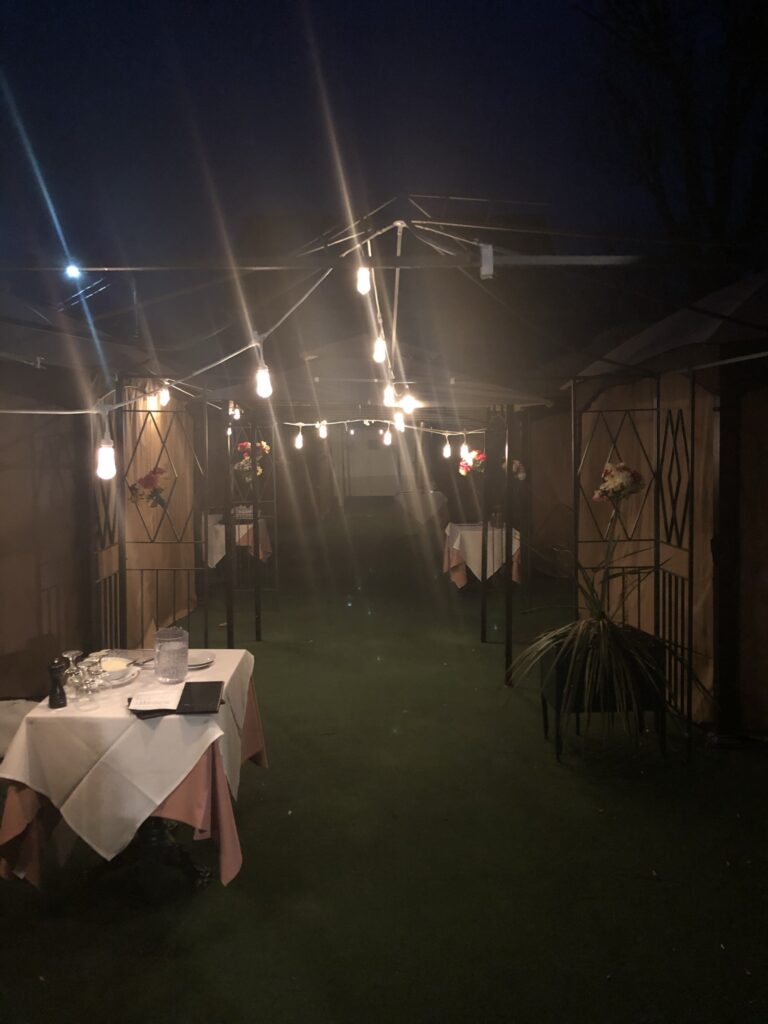Dash Shaw’s Discipline, out as of October from New York Review Comics, finds the artist in new territory, in terms of both subject matter and approach. The graphic novel, a Civil War narrative, is Shaw’s first book-length work of historical fiction and a fiction Shaw forms in part from primary documents of the era. (This technique, not present in his other comics, is distinct to Discipline’s long development process, which he explains in the conversation below.) Discipline follows Charles Cox, a 17-year old Quaker, as he leaves home and family to enlist in the Union Army. His sister, Fanny, remains at their Indiana colony of the Society of Friends, and the story traces the siblings’ parallel dilemmas of body and spirit.
Discipline does share with Shaw’s other graphic novels the marks of a stylistic shift, with more negative space than previous works—a complement to characters’ states of contemplation—in addition to more hatching and other departures. It’s a book that, at a glance, has little in common with a story like BodyWorld or even a more recent release like Cosplayers. But as with much of Shaw’s work, the literal and physical distances between people rank high among its concerns. Our conversation about Discipline was made possible through a release event hosted by Community Bookstore in Brooklyn, New York. It began with remarks from Shaw in which he guided the event’s audience through a series of images from the book. - Greg Hunter
* * *

Dash Shaw: This is the cover of the book. Quakers at this time, the only two art forms that they really practiced were silhouette portraiture and quiltmaking, so I tried to limit myself to those for this cover.
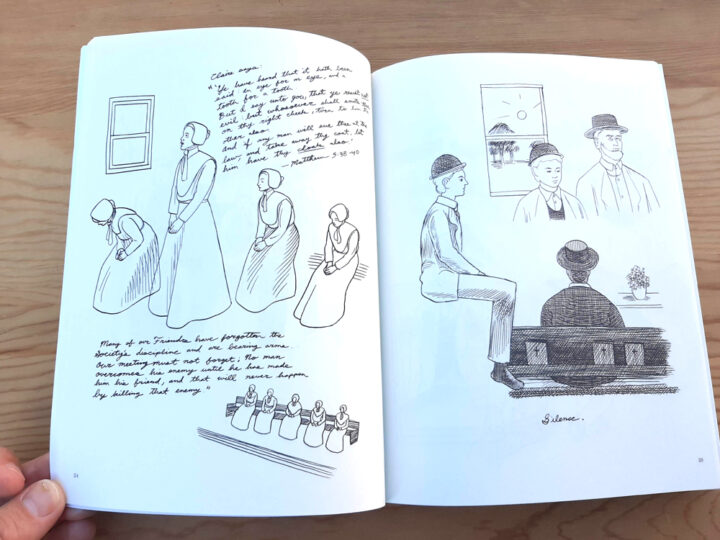
This is what the insides of the book are like. There are lots of scenes in meeting houses, and if any of you have been to one, you know the kind of gutsy-ness involved in standing up and speaking out of the silence. So that's what is going on here on the left. Sometimes breaking down a movement, decompressing it, is saying that this action is important. And she's speaking out against the war, saying that you don't overcome an enemy until you've made them your friend and that doesn't happen when you kill that enemy. Many Quakers on record for speaking out against the war were women. There is a rift in the Quaker community about whether or not to fight, so she's speaking against it. Many Quakers did fight.
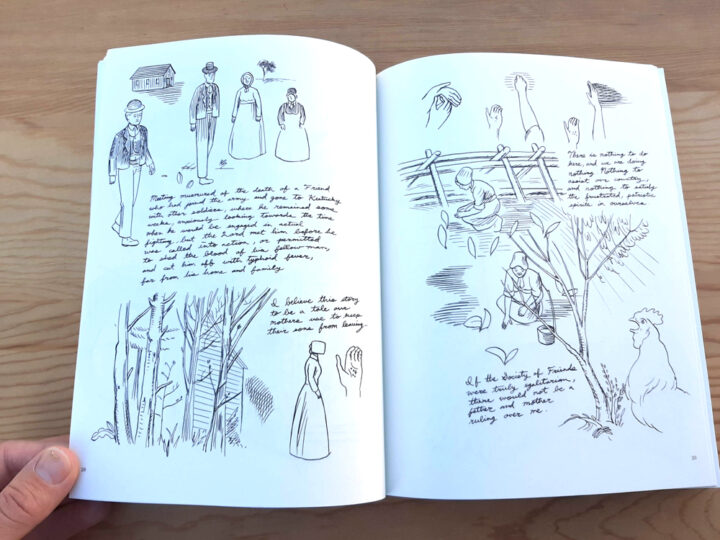
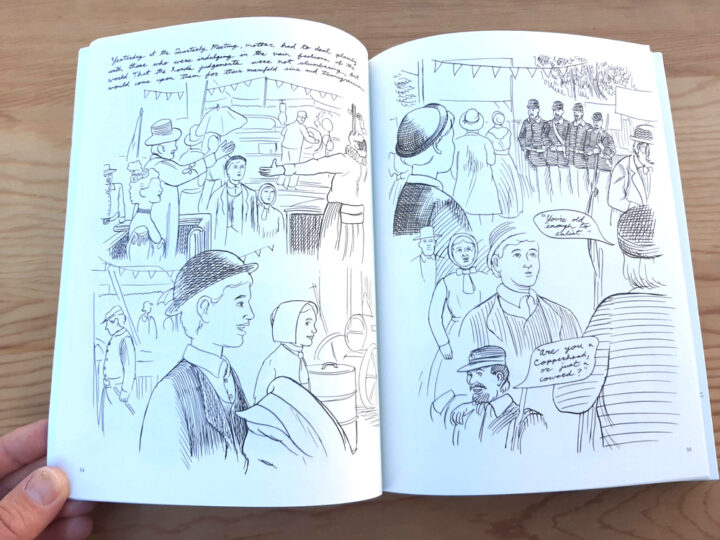
The text from the book mostly comes from actual Quaker letters and diary entries that were at the New York Public Library in their manuscripts and archives division. So, the book kind of feels like a long collage of found, altered text formed into a narrative. There's the conflict inside of the meeting house and the physical conflict that the boy’s going through.

The drawings float, which is, I hope, doing a few things at once. One was just kind of how I put the book together. I wanted to be able to research things and gather material. Instead of planning the whole book for a year and then trying to execute it over the years, I needed some kind of way to have construction be more fluid. So, I would draw scenes kind of not knowing exactly how they would fit in. So, then piecing it together kind of felt like a collage. That's one part of it.
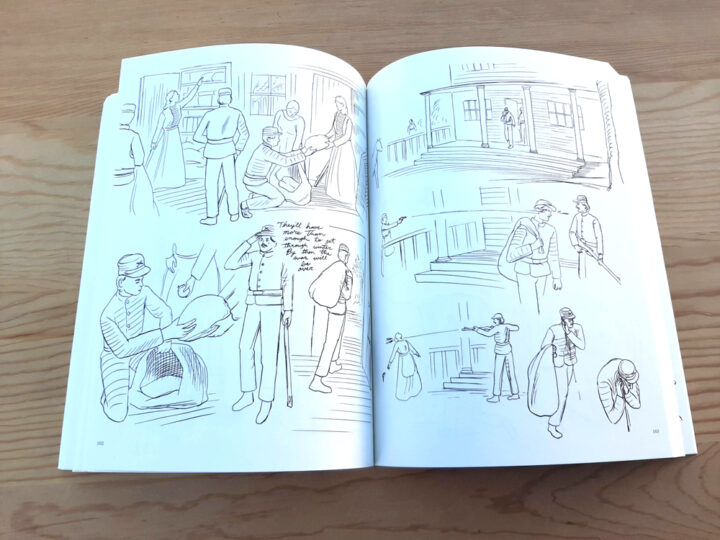
Another part of it is sort of like the Civil War-era “Specials” [also known as Special Artists]—the journalistic illustrators, the way that they would draw. And then the third part of it is, I hope, it feels like the silence of the page, the negative space of the pages, is activated in some way that's unique.

The book was drawn over so many years that the drawing on the right side of this page was done in 2014, and the drawing on the left was done in 2019, and I didn't know this would be the transition until it kind of aligned one day when I saw I could go from the arms of the mother and father to the arms of the boy. So that was a nice moment. That's what I was hoping for: unexpected moments of inspiration.

This is from a chapter in the book that's really important. That's the sister. It’s a mostly wordless chapter that’s suggesting things going on with the sister that she's not putting into the letters to the brother. Eventually, later in the book, we find out what the content is about.
* * *
Greg Hunter: Dash, you just discussed the kind of unusual construction of the narrative of the book, how the book revealed itself to you over time, to some extent. And I'm curious, in terms of that discovery process, if you ever reached a point in drawing the story when your storytelling instincts might have led you in a certain direction for a character or a scene, but discoveries about the historical record then pushed back or put you in a different direction.
Dash Shaw: You know, that was kind of the whole thing. When I first started it, I thought, "Okay, I have an office at this library, they have a ton of material here, I’ll be able to make something kind of like"—I love the Chester Brown book Louis Riel, and I thought it might be something like that, explaining this moment in history in a clear way. In literally like a clear-line kind of way, in [Brown’s] case. But then, when I got into the letters and diary entries, it was this mind warp.
Because I think some people, as they research things, [their subject] becomes clearer. Maybe Chester Brown was like this, like he had a confident idea of what was happening. But as I researched this, I actually felt like it became less clear. I would know that someone went through a battle that day, but their diary entry would just be what they ate or the weather. I would know all about what this person was like, but their diaries would be something completely unrelated. So then I had to kind of restart the whole book, thinking about the book. And that was very, very confusing, but it ultimately . . . Someone else could have looked at that material and been able to make a book that is more—I hate to use the word normal, because it is so meaningless—but something I guess more explanatory than my book.
I think my personality led me to make something that's more about the dissonance between what people are saying or thinking about or writing about versus what they're doing. And when I realized that’s almost the conflict of the book, what people are doing physically versus the text or what they’re writing about, then I thought, "You know, that only came from the letters". It wasn't a plan.
Again, I'm sure just due to my personality, I really liked the letters where I couldn't understand really what they were saying. Those were the most exciting letters. Even almost sometimes not being able to read the handwriting. At any kind of level, you're looking at this past, and there's something mysterious about the people in it, and you don't know how much they're like you . . . That was exciting.
Just the notion of those diary entries as the products almost of real-life unreliable narrators, it's a fascinating thing. Along those lines, you are, for lack of a less embarrassing term, a comics auteur. The books all feel like the product of some pretty rigorous work and have a pretty cohesive vision. So I was curious, using these sorts of found texts, if that process complicated your feelings of authorship at all. If it felt like a collaboration in a way that's distinct from the earlier works.
That’s interesting—I know what you mean. I guess there's a few things. Maybe making animated movies has helped me lean into this direction, but I feel like I'm an orchestrator or arranger of different elements. And so when it came to the text, even if I didn't necessarily write that text, I'm still directing it. For Cryptozoo and these movies I've made, I’ll storyboard it, but I don't necessarily have to be the person who's painting a particular background. If I can find someone who paints better than me, great. So that kind of authorship, I feel like I'm the orchestrator, the collage-artist kind of person.
You know, it's kind of funny saying that, though, because I do think with these books, it is important that I draw everything. I don't really have the impulse to be a writer who makes layouts or whatever and finds an artist. So that part is important, but that's only maybe because I want to be in charge of all of those arrangements.
In my book about your work—New Realities: The Comics of Dash Shaw, coming sometime in early 2022 now...
Oh, no!
...it’s the supply-chain thing. One argument I make about your books in that book is that usually a biographical reading of them is not going to be the most fruitful way to think about them. And I still generally think that's true, but Discipline complicates that idea. Because you're separated from your characters by more than a century, but knowing that you had a Quaker upbringing, and that this is your first graphic novel to feature a Quaker community, I was hoping you’d share some thoughts about how you found yourself bringing an experience of Quakerism to the story and how much of your own experience you see reflected in that final work.
First, I feel like I should zoom out and just publicly for the record, thank you for writing that book. And while I haven't held it in my hands yet, I read a PDF, and I said this to you, too: I felt like if I have one complaint, it’s that it’s only about me. I was very grateful. Of course I’m flattered that it’s about me, you know, I think it’s cool that it's about me, but I feel like there’s so many cartoonists that are after the kind of people who got those books about them, Chris Ware and Dan Clowes, that are very deserving of having someone go through their work, whether it be Kevin Huizenga or Gabrielle Bell—I can name lots of them. So I hope that yours is one of many of these books, and it's very cool that Uncivilized published it.
But about [Quakerism]—if you grow up in those meeting houses and you have to spend an hour in silence when you're three, four, or five years old, you just get a different relationship to silence. And it felt like I had this muscle in me that was strong after over 30-plus years of doing that. And I got to use it in this book. Meaning, I don't think someone else could have drawn those meeting-house scenes—that negative space and the kind of activated silence. I could be delusional or something, but it doesn't matter, because it felt to me like I was using something that was inside of me. And that was very, very exciting.
[Negative space] is also throughout the book, and it kind of keeps the book consistent in its treatment of silence and these things emerging out of the silence. Whereas, otherwise I think it might it might just be a bunch of stuff, a bunch of scenes, a bunch of text. And similarly, you know, growing up in Richmond, I felt very early on that—and many people have said this about Richmond—it’s a haunted city, that the fallout from the Civil War is ever-present in the humidity of the air. You know, that unaddressed ghosts were in this city. So, that again felt like there was something I was tapping into, but I couldn't make any claims beyond that. Meaning, I don't know how interesting it would be to try to go through my diary and point to particular things that made me want to do something or other. That would probably, just like the [wartime] diaries we were talking about earlier, only confuse things.
I always find, even when I’m talking right now—well, I’ll even remove myself. Often times, I hear another cartoonists or an author speak about their work, and I’ll think, That's not true. I saw your book—you know, to me, it’s obviously more about this than what you’re saying. So, I'm sure I'm probably just as delusional and misguided, or maybe I'm finding something that sounds like it's a good thing to say, whereas I was actually doing some other thing that I'm not aware of. You know, the unconscious is such a huge space that, when an artist talks about their motivation or something, I find, maybe the majority of the time, I just find it not worth hearing.
Let me ask you something slightly more concrete, since you mentioned Richmond—and hopefully this is clear to [the reader], but Richmond is where you're from. It's also where some of the story’s bleakest scenes take place. I was curious, do the remnants of Libby Prison still exist in Richmond?
No, not the remnants, but I went there, and it's a plaque on the floor of a parking lot. Though, the past few years obviously have really helped . . . You know, I live a couple blocks away from Monument Avenue. So all of the protests and eventual monument removals felt like they were addressing [Richmond’s] ghosts, when for many, many years, it was just kind of on the ground, in the earth, just sitting there at your feet.
Now this is obviously a Civil War book. And there’s a consistent aesthetic and a consistent approach throughout, but at the same time, there's real contrast between those meeting scenes and the scenes of wartime combat. You mentioned earlier Louis Riel by Chester Brown, and that drawn reportage contemporaneous [to] the Civil War was a point of reference for you. Of course there's a long tradition of war stories in comics. High points like the work of Jacques Tardi or Harvey Kurtzman, also a lot of stuff that's, you know, closer to propaganda. So I was curious, in drawing the book, and with respect to combat scenes or other elements of war, if you had any other significant comics reference points.
Well, maybe not comics, but the Specials were huge deal. Because the library had their actual sketches, so you could see how, you know, Alfred Waud drew—like the scale of his drawing, how he would use text in it, and then see the resulting etching that was in Harper's Weekly or whatever. Because, before I got into [the project], I would be like, "Why does all Civil War era illustration look the same?" Like, it looks like they draw the same trees. And you know, it's really a result of this production line where there would be a team of etchers, and there would be like The Tree Guy, who's doing the background trees and taking the different artists’ sketches—almost like a Hollywood production line. Or more like an inker with a strong hand going over different artists’ pencils and interpreting it in their own way.
So the thing that was key was—this is getting really in the weeds, but I’ll go for it. I couldn't draw something so dense, to be like those etchings. Not only would I have not have been physically able to do it, but I don't think it would read. And then I didn’t want it to look like Tintin or Louis Riel—I didn’t want cartoony-faced cartoony little beings. So I tried to find some kind of sweet spot where it's realistic enough but also feels like it's happening. And that's a weird thing that I think maybe only people really keyed into comics get, but there's a difference between seeing something that’s frozen—frozen moments in time—versus something that feels like it's happening in front of you. Maybe the happening-in-front-of-you part feels more like Japanese comics that are decompressed. I can't really say, but I wanted it to have a happening-in-front-of-you feeling, especially when you're drawing some of these forests, where you're like, I want it to feel like, ‘Oh, maybe it was drawn in a forest,’ you know, it has some of that vibe.
[And] that Civil War-era illustration—John Tenniel, one of the most famous examples of this—where it's like, groups of lines depicting space, but there's key information missing, such as some someone standing on a floor, and there’s a group of lines that's the [person’s] shadow. And then those lines suddenly move up at a certain point. And we recognize it as the point where the shadow meets the wall, but we're missing the line that's the edge of the floor with the wall. We're only getting those groups moving up.
So, there are whole spaces rendered in this kind of freaky way that was developed in groups of hatching describing things. I thought that mode inside a panel-less comic where all of the space is kind of activated would be appropriate for the book.
We see hatching from you in this book to, I think, a greater degree than in most or any of your other graphic novels, which I found really just effective in this context. In conveying something like the weight of a human body, in the midst of these scenes that also have a ton of negative space—scenes that otherwise have a certain airiness to them, where we get that sort of literal and visual silence—at the same time, there is like a real tactile quality of the book I think pairs well with the contents of the book, the effects of war.
A lot of that was taking a drawing and photocopying it and then hatching it in a bunch of different ways, and then trying to find the right level of hatching that was still legible. Especially in this book, where your eye is scanning through it to pick up text. The text isn’t highlighted inside of word balloons. So, if you rendered something in a denser way, your eye would just kind of spend more time on that part of the picture. So, it was kind of interesting to just have like five versions of one drawing and pick the one that felt the best for the book.
Now, a bit of background for people who haven't read the book yet: A big part of the story is the disillusionment of the Charles character—one of the two major arcs. He first breaks with his community to join the Union Army because he recognizes the depth of the evils of slavery, but as the book proceeds, he seems to find himself disturbed by the process of war—how even Union tactics affect civilians, and the basic sight and act of doing violence to another person. There’s a parallel to something like Slaughterhouse-Five, in that Kurt Vonnegut expects a reader to understand implicitly the horrors of Nazism but also to conjure some moral revulsion about the firebombing of Dresden.
Part of why I wanted to talk about this is because some of the discursive platforms on which people are going to be talking about this book sometimes have the effect of flattening conversation. Twitter is not always the best for nuance, and it’s possible to imagine a reading of the book as a “both-sides-ing” of the Civil War. I don’t think that’s what it does—I saw the story more as mounting an argument that the means and mechanisms of war can degrade a person morally, irrespective of the war’s purpose. But I did want to know what kind of apprehension you felt, if any, about that aspect of the book, and ask what sort of reactions you’ve experienced so far.
Well, first, I felt apprehension about kind of everything involved with this book, which is part of what made it so hard to to work on. I second- and third- and fourth-guessed everything about this. So, full of self-doubt on every page that had to get hammered out through time and kind of exploring different ways.
You know, I tried to be very clear that [Charles] is leaving his community because he’s sick of his mom and dad telling him what to do and he wants to get out of the house and see the bigger world. I felt like I really, really made it clear that that was his motivation. And then the other things kind of come after that, but in those first couple chapters, I really tried to emphasize . . . You know, the end of Chapter One is him saying, like, if the Quaker meeting was truly egalitarian I wouldn't have a mother and father ruling over me. So I feel like, with these kinds of things, I am planting in the book in a way that is appropriate from the perspective of that character, as opposed to an outside force. You know, I feel like my contribution is in the arrangement and also in the drawing, kind of the inflection of a lot of this material.
About the kind of second part of your question, which is how people will try to reduce something on the Internet . . . I don’t know. The book has just come out. It could be my fault, but the book is so weird and full of contradictory kind of information that I don't think a reading . . . I shouldn’t say that. Because when you have something that has a lot of literal negative space in it, you're really inviting people to to fill it in, and if they have something they're bringing to it that they're upset with, they're gonna bring it to what they do.
The only kind of time I've experienced this is on Cryptozoo, in a pretty bizarre way, because we have a character talking about storming the capital at the beginning of Cryptozoo. And it was written in 2016, and we recorded Michael Cera saying [it] in 2017. And then it came out two weeks after the January 6 attack. [Then] Sundance was that month. So you had this major thing that you know is at minute six of the movie. And I think that the fact that Sundance was virtual this year . . . I guess my point is, I couldn't have digested that being real as part of my project, because it hadn't happened.
Then it's sort of this beholder’s-share idea, the viewer completes the picture in their mind and I, you know, gave them 70% and they're picking the 30% of how they’re interpreting and filling out the material. And because that Sundance was virtual, it was at home, and I think that made it more like a reading experience, where everyone kind of on their own had to decide, "Okay, wait—what is this talking about here? Was this made before [the attack]?" If it had premiered, you know, in a festival full of 100 people, everyone would have felt the ripples through the audience of . . . I don’t know what. Confusion? A bunch of people would have left, because they would have been like, "This movie is crazy". So, the reading experience, I think, maybe benefits an individual's attention.
In terms of the space you leave for a reader to make interpretations—which is, I think, generous in this book, so maybe I already know the answer to this question—but comparing Discipline to a project like Cosplayers, which is just a more lighthearted work . . . To whatever extent you do work to influence an interpretation, when a comic of yours has themes of greater severity or whatever, do you find yourself working harder to determine the parameters of someone's reading? Or in both cases is [it] just your process that instinctively you leave that space and make your peace with them?
You know, making things is—this is such an obvious thing to say, but since we're talking so abstractly, I have to say it. It's your relationship to the unseen reader. How much do you trust this person? Do you love them? Do you not trust them? Are you concerned that you're not communicating this? You don't know them.
So, what can be a real mind warp—again, this is something that I've experienced more with film than with books—is you make your movie, and you show it to people, you'll do maybe like a kind of test screening of 12 people, and five people didn't understand something, and six other people got it, and then this one person thought it meant this other thing. And you're like, "Okay, what do I do with this information? Do I change it? Do I not change it?" And that decision is, I would say, the hardest thing about directing, especially as you're working on something for so long.
Even if you don't have an evil producer over you, telling you to change something, you still . . . You know, I worked on Cryptozoo with my wife Jane. You know, my wife is telling me like this line doesn't make sense or people think it doesn’t . . . So, ultimately, the good thing about [Discipline] taking so long is I did get to explore different options for how each of these things are handled. I'll pick a really basic one.
We have to two characters writing letters. And at some point along the line, their handwriting's the same. I thought, "Well, I should have one of the characters have a different handwriting through the book, so we know which letters are from the sister and which are from the brother, because it's kind of confusing". So then I asked my mom, who has great hand-lettering, to do all of this lettering for Fanny, the sister, and I put it into the book and substituted out my lettering. But it didn't feel right. Then, I tried it in my own hand, but differently, so it's the same person, but I'm doing a slightly different inflection of the handwriting. But it felt too much like, "Now you know who's writing that letter". The extra attention of just recognizing that felt too clever. It was weirdly distracting to the content of the book. I'd rather it just be text and remove the split-second thought, where you have to think, "Oh, this is from Fanny". I would rather remove that [thought] and just have it float up.
Many people would have said, "You can't do that, you know, there's all this text, you don't know who it's coming from". So I made that decision. That's kind of an easier one to cite as an example.
Well, that makes sense as a conscious choice—a conscious challenge you know you are leaving for the reader to work with. Because you've touched a bit on you know the parallel tracks of making comics and also directing animated films, I wanted to get more granular with that.
Throughout the book, even in non-combat scenes, some of the compositions have you depicting motion, especially bodies in motion in ways I think are outside normal comics techniques. I'm thinking of the card-dealing scene at the military camp, the cock-fight scene, the men brawling over a stolen knife. There's a memorable coffin-assembly scene later on. So I was wondering if directing animation has impacted how you approach motion comics. How porous do you think the boundaries of those mediums are in terms of how one affects your approach in the other?
About the bodies, you know, it's something that comics does very well, in kind of like a Muybridge way, where it can really shoot meaning into physical action. And shooting meaning can mean different things depending on the scene. Maybe animation has something to do with that, I'm not sure. In animation, it's so different, because it's not occupying the same space, it's going through time.
I think that the main thing that film has taught me is editing. Because most comics are not edited. They don't get that opportunity because of how they're made. Meaning, I know they are edited by an editor who's making suggestions to the story or the pencils or something, but I mean whole scenes are not rearranged and restructured the way they are in the editing rooms of films. Like, in this book, there's all of this stuff where the meeting house is debating about how much of the taxes to pay, or whether or not to pay taxes that are going towards the military. And that kind of piece came from these Friends journals that I found late in the process. And when I figured out how to dramatize that, I then like laid it into these other scenes, and the book like finally felt like a book and not just a long collage.




